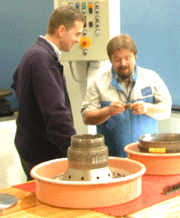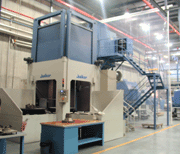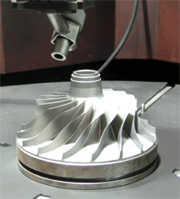E-Archive
Interview
in Vol. 5 - March Issue - Year 2004
Engine Repair with Dedication

Jos


High End CNC Shot Peening Machine

Engine Part for Shot Peening Treatment
Interview with José Antonio Gutiérrez, Repair Component Manager at ITP Shop in Ajalvir, Madrid/Spain
Industria de Turbopropulsores, S.A. (ITP) was created in 1989 by merging companies from the public and private sectors of the Spanish Aeronautical Industry together with the British Company Rolls Royce PIC. The creation of this company is the outcome of the longstanding desire of the Spanish Aeronautical Sector to join again the small group of countries that lead the aeronautical engine industry, in which the Spanish sector had achieved great success from 1915 to 1960. The creation of ITP pursues the objective of promoting a national aeronautical engine and gas turbine industry. The ITP group is involved in activities such as research, design, development, manufacturing and maintenance of engines for aeronautical, naval and industrial applications such as power generation and has several facilities in Spain, UK and USA.
(?) MFN: Mr. Gutierrez, your facility is located in Madrid, Spain. Can you briefly describe the activity that your shop develops within the ITP group?
(!) J. G.: The Ajalvir plant is the source of all the aero engine tradition and experience in the country. The former company Elizalde was created in 1950, years later was called Enmasa and in the early seventies became the aeroengine branch of Construcciones Aeronáuticas, S.A. from where it was bought in June 1990.
The activities of this plant are focused on the assembly, repair and overhaul and testing of gas turbine engines.
The plant is spread over an area of 100,820 m2, of which 15,000 is built on and has an annual production capacity of over 300 engines and corresponding accessories and spare parts. The range of engines overhauled in this plant has allowed us to become the official maintenance centre for most aero engine manufacturers.
Over the years, we have repaired and overhauled well over 6,000 engines. Component repairs can be counted in tens of thousands.
ITP Ajalvir offers a variety of engine maintenance programs, new and overhauled parts distribution as well as maintenance of accessories.
(?) MFN: If someone see the means and equipment at your shop for the first time, there is no doubt they will be surprised by the amount of investment carried out at these difficult times being suffered by the aerospace business.
(!) J. G.: ITP Ajalvir is developing an ambitious investment plan that will reach 42 million Euro from 1998 to 2003 as part of the Strategic Plan that includes construction of new facilities, upgrading the old ones and acquisition of new equipment. We are incorporating state-of-the-art new equipment in welding, machining and surface treatment. The purpose is to enhance the work conditions, improve capacity in developing new repairs, and increase company metrics and results in general.
Independent repair shops play an important role by specialising in repairs. By incorporating repaired parts instead of new ones, the cost of the engine shop visit can be reduced considerably.
We think that the technology in the R&O business is placed in the repair process. The rest of the tasks carried out to maintain the engine as assembly & evaluation are intensive in labour with risk of being located in other countries where labour rate is cheaper. The investment in repair area ensures the future in this activity.
(?) MFN: The aerospace sector is very severe to ensure the airworthiness of the aircraft parts by means of approvals and quality awards. Which certificates have been obtained by ITP?
(!) J. G.: ITP Ajalvir is a JAR 145 maintenance organisation approved centre. Recently, the FAA Certificate has been obtained providing more possibilities of improvement. Overhaul and repair are also performed in accordance with ISO 9001:2000 and PECAL/AQAP 110 standards. These certificates not only allow us to repair Commercial Engines but Military/Government engines as well.
(?) MFN: In the engine maintenance market, what is the part of business taken by ITP?
(!) J. G.: Mainly, aircraft operated by government agencies and military organisations. We are currently dealing with corporate/general aviation customers to gain more workload in this market. The engines supported by ITP are the following: Honeywell- TPE 331, TFE731, T55 and T53, GE Aircraft Engines- CT7, F404 and CF700, Pratt&Whitney- PW100 and PT6, Rolls Royce- A250 and BR715, Snecma- ATAR and Turbomeka Makila.
As you can appreciate the capability list is large to gain market in the future.
(?) MFN: We are going to focus on the surface finishing process. What are your means for the overhauling of aircraft engines?
(!) J. G.: We have gained an important reputation in the surface finishing sector. Let me begin by saying what our process is.
Before repairing the engine components it is necessary to clean their surface to eliminate grease, oil, oxides, strange materials and previous surface coatings. For that purpose, ITP Ajalvir has two petroleum solvent spray cabins, a vapour degreasing cabin , vibration systems, grit blast as well as a chemical cleaning line, fully automatic. The operations carried out in this section are done environmentally clean ( ISO 14000) and safe for the operators.
The function of the cleaning process is to remove, as much as possible, the waste products deposited during service time on the engine parts. The usual deposits are made of thermal oxides and carbon leftovers coming from the combustion, lubrication system, etc., which polymerise at working temperature and remain strongly attached to the part surface.
The current cleaning usually includes degreasing and previous cleaning, and an alkaline treatment to eliminate oxide and coal dust.
As far as the thermal oxide is concerned, cleaning it is necessary to re-oxidate with an oxidant agent and combine acid and alkaline treatment in various phases until leaving the part’s surface completely clean. This line also has a silicones and paintings elimination process.
ITP Ajalvir has an automatic cleaning line consisting of 22 tanks (capacity 5.000 – 7.000 dm3) which cover an extension of 30 x 7 m2 in the shop. This line can automatically operate several processes at the same time being controlled by a PLC that manages the baskets. This allows high productivity and substantial improvement in terms of workers and environment health. At this point in time 17 different processes have been developed by automatic chemical cleaning to provide an answer to the original equipment manufacture (OEM) maintenance requirements.
Also, there are dry and wet grit blast cabins to help cleaning and surface preparation with mechanical procedures. These cabins use white corindon 24 and 220, glass microperl 55 – 105 and wallnut shell size 0.4 – 1 mm for dry blast cleaning and Quartz 40, glass microperl 55 – 105 and glass microperl 105 –210 for wet blast cleaning as abrasive materials.
We have also vibration equipment filled with ceramic chips to clean blades and small pieces.
(?) MFN: Why do you think that surface finishing processes are key ones in your repair procedure?
(!) J. G.: The surface treatment operations are fundamental in maintenance because they prepare the parts for the rest of the tasks to be taken as NDT (non-destructive testing), inspection, plating , thermal spray, painting, shot-peening, welding, etc. Without properly performing these tasks we couldn’t warranty a good standard previous to the following processes or we will reduce the operation life of the part once mounted on the engine.
(?) MFN: Shot peening is a process widely used in the aerospace industry. I would like to talk to you about CNC shot peening machines for aircraft engine application and how is ITP Ajalvir involved in this matter ?
(!) J. G.: Shot peening is a process that induces compression stresses in the part surface, by using the effect of small metal balls stream thrown over the surface at high speed and under controlled conditions.
Although the shot-peening process cleans the affected surface this is just a side effect. The basic objective is to increase the resistance to metal fatigue and/or prevent the cracking due to the combined action of stress and corrosion.
Most of the service failures, are originated by the residual tensile stresses on the part, which were induced during manufacturing or repair. These stresses widely reduce the cohesion between grains at the surface of the part. Because of this, most of the fissures and cracks due to the metal fatigue and stress-corrosion originate in the surface of the parts.
In order to solve this problem, the best solution is to change the superficial residual tensile stresses into compression stresses, with the controlled application of the shot-peening. The resultant layer, of several tenths mm depth, holds induced compression stresses that actually delay the cracking start and propagation under stress and corrosion at working environment. Maximum residual compression stress that can be produced in a superficial layer by shot–peening is equal to half of the stress of the elastic limit of the metal.
Shot peening process must control the material properties, size and shape of the peen, impact conditions as shot angle, distance to the part and particles speed. Also rate of flow and the exposition time must be controlled. In this way, to obtain high compression in small depth layer requires small particles, high speed and a relatively low rate of flow. A deeper compression, needs the use of bigger particles and lower air pressure, that means lower speed.
Shot peening of aircraft parts needs strict control of all of the above parameters to ensure the optimum final result. Also, complex geometry of the parts such as bucked grooves where you insert the blades on a fan disk or cooling holes on a turbine disk need careful application of the process. When you need to apply this process to a large amount of parts of complex geometry and different shape, the whole process including masking and peening can be highly time consuming.
In this way, by incorporating a CNC machine and the application of dedicated masking procedures one can reduce time and cost to the whole repair.
ITP Ajalvir has a shot peening equipment BAIKER AG, SERIES 5 that allow us to peen hubs, disks, blisks, fan blades, compressor blades, airfoils, etc. The system can work with parts up to 1,900x2,200x1,900 mm and 500 Kg in weight. The system has a size classifier and shape classifier for the peen and flow and pressure controls. Three types of peen are used: S110, S170 and S230. A SPC (statistical process control), a tool to calculate the Almen saturation curve helps to comply with the aeronautical requirements.
The equipment is also friendly with the surrounding cells by producing a noise emission not bigger than 70 dbA.
We at MFN would like to thank Mr. José Antonio Gutiérrez for this interview.
For Information:
Industria de Turbopropulsores, S.A. (ITP)
Ctra. de Torrejon-Ajalvir, km. 3,5
Apartado 11, 28850 Torrejon de Ardoz
Madrid, Spain
Tel.: +34.91.205 45 01
E-Mail: j.gutierrez@itp.es



























